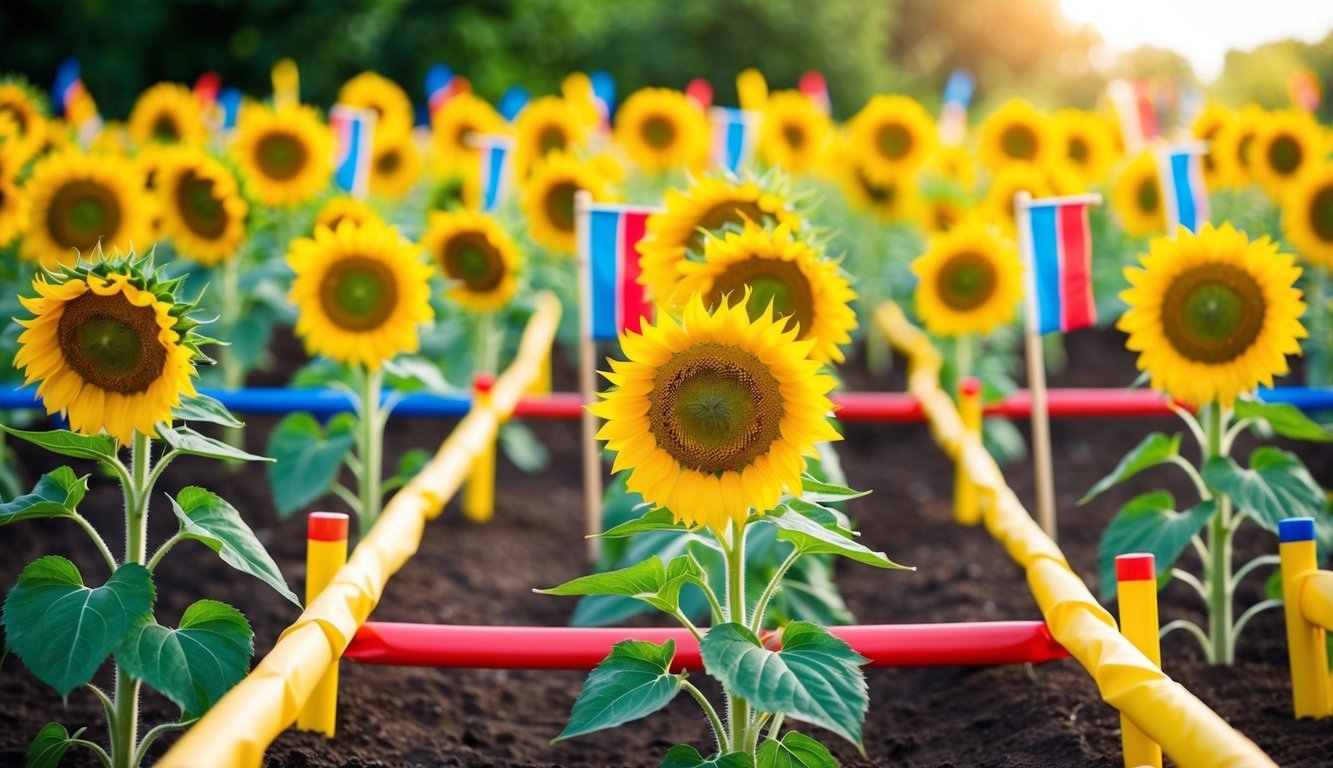Gardening is more than just a hobby; it’s a fantastic way to connect with nature while teaching kids invaluable lessons. I believe that hands-on activities can ignite a passion for the environment and help children appreciate where their food comes from.
Whether you’re working with a small balcony or a spacious backyard, there are countless ways to engage kids in gardening.

By incorporating fun and creative methods, I can foster their curiosity and critical thinking.
It’s rewarding to see kids experiment and learn through nature, so I’m excited to share some enjoyable ideas that make gardening a memorable experience for young learners.
Plant a Pizza Garden
I love the idea of planting a pizza garden with kids.
It’s a fun and interactive way to teach them about where their food comes from.
Plus, who doesn’t love pizza?
To get started, I choose easy-to-grow plants like cherry tomatoes, basil, and oregano.
These ingredients will make our homemade pizzas tasty.
I let the kids help with all the steps, from planting the seeds to watering the garden.
They get excited about watching everything grow.
It’s like a little adventure!
As the plants start sprouting, we talk about gardening concepts like sunlight and soil health.
This hands-on experience helps them learn without it feeling like a lesson.
Harvesting the ingredients brings everything full circle.
I love seeing their excitement as we pick fresh veggies for our pizza night.
It’s rewarding to eat something we grew together!
2) Craft Butterfly Feeders
Making butterfly feeders is a fun and creative way to engage kids with nature.
I love using recycled items for this project.
It sparks their imagination and teaches them about reusing materials.
One simple idea is to use a clean plastic bottle.
I cut holes in the sides and fill it with a sugar-water solution.
The butterflies are attracted to the sweet scent.
Another great option is a saucer with sponge pieces.
I soak the sponge in sugar water or place overripe fruit like bananas or oranges on it.
The bright colors and scents draw butterflies in.
Kids can personalize their feeders by decorating bowls with colorful beads or paint.
This adds a special touch to the feeders while capturing butterflies’ attention.
Creating these feeders provides a hands-on gardening experience, encouraging kids to observe the butterflies that visit.
It’s a wonderful way to combine crafting with learning about ecology and pollination.
Create a Worm Compost Bin

Creating a worm compost bin is a fun and engaging way to teach kids about gardening and sustainability.
It allows them to see how vegetable scraps can transform into nutrient-rich compost.
I recommend starting with a plastic storage container.
Drill about ten small holes in the sides and bottom for air circulation and drainage.
Don’t forget to cover these holes with a piece of screen to keep the worms safely inside.
Once your bin is ready, add some pre-moistened bedding, like shredded newspaper or cardboard.
This gives the worms a cozy home.
Next, introduce the worms.
Red wigglers are great for composting.
Kids can help feed the worms kitchen scraps like fruit peels and vegetable trimmings.
It’s a hands-on lesson in decomposing organic matter, and they’ll see the worms at work.
Regularly checking on the bin also teaches responsibility.
Kids will love observing how worms break down the scraps and create rich compost they can use in their gardens.
4) Start a Sunflower Race

Starting a sunflower race is a fantastic way to get kids excited about gardening.
I love the idea of encouraging children to plant mammoth sunflower seeds.
They grow quickly and can reach impressive heights, making the competition even more thrilling.
To kick things off, I give each child their own seeds and pots.
It’s fun to watch them decorate their pots, adding their names and designs.
I make sure we have a sunny spot or use grow lights for the seeds to thrive.
As the sunflowers grow, I encourage everyone to document their progress with photos.
It becomes a fun visual journey to track each plant’s height and development.
To add a bit of excitement, I suggest prizes for different categories.
Kids can compete for the tallest sunflower, the largest head, or even the most sunflowers from a single seed.
Prizes can be simple, like a small trophy or a gardening book.
The whole experience fosters a sense of adventure in the garden.
It’s engaging and teaches kids about patience and the wonders of nature.
Plus, it’s a blast to see whose sunflower will reach for the sun first!
5) Set Up a Sensory Garden

Creating a sensory garden is one of my favorite activities to engage kids.
It invites them to explore and experience nature through all five senses.
I love including plants with different textures, scents, and colors.
Soft lavender, bumpy cucumbers, and fragrant herbs like mint are great choices.
They can touch, smell, and learn about each plant.
Adding features like a crunchy gravel path or a gentle water fountain can enhance the experience.
The sound of trickling water creates a calming atmosphere.
I also encourage kids to pay attention to sounds around them.
They can listen to birds, rustling leaves, or even the wind.
It helps them connect with nature in a unique way.
Accessibility is key.
Planning pathways and raised garden beds ensures that everyone can participate.
This makes it fun and inclusive for kids of all abilities.
Setting up a sensory garden not only teaches gardening but also helps kids develop observation skills and creativity.
It’s a fantastic way to spark joy and curiosity.
Benefits of Gardening for Kids
Gardening provides numerous advantages for children, fostering essential life skills while also benefiting their physical and emotional well-being.
Engaging in gardening activities can spark creativity and instill a sense of responsibility in young learners.
Enhancing Creativity
Gardening allows kids to express their creativity in various ways.
They can design their garden layout, choose which plants to grow, and even create decorations for their space.
This hands-on experience encourages them to think outside the box.
While planting seeds, they can experiment with colors, shapes, and arrangements.
Watching plants grow and bloom lets them witness the results of their imaginative efforts. Incorporating elements like garden art or themed sections can add another layer of fun.
Using different tools helps them understand how each item contributes to the gardening process.
This interaction fosters an environment where creativity thrives, making the gardening experience both educational and enjoyable.
Improving Responsibility
Caring for plants teaches kids about responsibility.
Each plant requires specific attention, from watering to weeding, creating a routine that holds them accountable.
They learn that neglecting their duties can lead to wilting or dying plants.
Setting daily or weekly tasks can help establish a sense of commitment.
It’s a practical way for kids to experience the outcomes of their actions.
For example, they might note that consistently watering their plants results in healthy growth.
By tracking plant progress, children build a connection to their work.
This teaches them life lessons about diligence and commitment.
Gardening becomes more than just a hobby; it becomes a tool for personal development.
Gardening Basics for Kids
Teaching kids about gardening starts with some essential knowledge.
It’s all about understanding plants and knowing what tools to use.
Let’s dive into these important topics to make gardening a fun learning experience.
Understanding Plants
When I introduce kids to gardening, I like to start with the basics of plants.
It’s fascinating for them to learn about different parts of plants—roots, stems, leaves, flowers, and seeds.
Each part serves a unique purpose.
I often explain how roots absorb water and nutrients, while leaves are vital for photosynthesis.
Kids can make a simple chart that labels each part of a plant, which reinforces their learning.
It’s also important to talk about what plants need to grow: sunlight, water, air, and soil.
I’ve found it helpful to create a visual guide showing these elements.
Engaging kids with hands-on activities like planting seeds and observing their growth makes the experience memorable.
They can keep a journal to track changes and feelings as they nurture their plants.
Choosing the Right Tools
Proper tools can make gardening easy and enjoyable for kids.
I always emphasize the importance of using kid-friendly tools.
Hand tools like small shovels, trowels, and watering cans are easier for little hands to manage.
Here’s a quick list of essential tools to get started:
- Small shovel: Perfect for digging and planting.
- Trowel: Great for working in the soil.
- Watering can: Helps them learn how to water plants gently.
- Gloves: Keeps their hands clean and protected.
I also encourage kids to personalize their tools.
Decorating gloves or painting a watering can can make the experience more exciting.
Teaching them about tool safety is key too—always remind them to handle tools carefully.
This approach makes them feel responsible while fostering a safe environment for learning.

